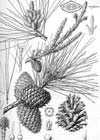Conservation Status

Pinus rigida
Miller 1768
Common names
Pitch pine; pin rigide [French]; リギダマツ [Japanese].
Taxonomic notes
This species belongs to subgenus Pinus, subsection Australes Loudon, clade Taeda (Cruz-Nicolás et al. 2024). This clade is comprised of species found in the SE US. P. rigida is known to hybridize naturally with P. echinata (Kral 1993). The two species introgress over a wide area in eastern Kentucky (and perhaps elsewhere where sympatric), producing trees with very small, P. rigida-shaped seed cones, and larger seed cones that are intermediate between the normal shape for each species (R. Clark email 2009.12.15).
Description
"Trees to 31 m; trunk to 0.9 m diam., straight or crooked, commonly with adventitious sprouts; crown rounded or irregular. Bark red-brown, deeply and irregularly furrowed, with long, irregularly rectangular, flat, scaly ridges, resin pockets absent. Branches arching-spreading to ascending, poorly self-pruning; 2-year-old branchlets stout (mostly over 5 mm thick), orange-brown, aging darker brown, rough. Buds ovoid to ovoid-cylindric, red-brown, ca. 1-1.5 cm, resinous; scale margins fringed, apex cuspidate. Leaves 3(-5) per fascicle, spreading to ascending, persisting 2-3 years, 5-10(-15) cm x 1-1.5(-2) mm, straight, twisted, deep to pale yellow-green, all surfaces with fine stomatal lines, margins serrulate, apex abruptly subulate-acuminate; sheath 0.9-1.2 cm, base persistent. Pollen cones cylindric, ca. 20 mm, yellow. Seed cones maturing in 2 years, shedding seeds soon thereafter or variously serotinous and long-persistent, often clustered, symmetric, conic to ovoid before opening, broadly ovoid with flat or slightly convex base when open, 3-9 cm, creamy brown to light red-brown, sessile to short-stalked, base truncate, scales firm, with dark red-brown border on adaxial surface distally; apophyses slightly raised, rhombic, with strong transverse keels; umbo central, low-triangular, with slender, downcurved prickle. Seeds broadly obliquely obovoid-deltoid; body 4-5(-6) mm, dark brown, mottled darker, or near black; wing 15-20mm. 2n=24" (Kral 1993). See García Esteban et al. (2004) for a detailed characterization of the wood anatomy.
Distribution and Ecology
Canada: Ontario and Québec; S through USA: Maine, New Hampshire, Vermont, Massachusetts, Rhode Island, Connecticut, New York, New Jersey, Delaware, Pennsylvania, Maryland, Ohio, Virginia, West Virginia, Kentucky, Tennessee, North Carolina, South Carolina and Georgia. Upland or lowland sites on sterile, dry to boggy soils; at 0-1400 m elevation (Kral 1993). See also Thompson et al. (1999). Hardy to Zone 4 (cold hardiness limit between -34.3°C and -28.9°C) (Bannister and Neuner 2001).
Distribution data from USGS (1999).
Remarkable Specimens
The largest on record is diameter 129 cm, height 29 m, crown spread 13 m, located in Newberry, New Hampshire (American Forests 1996). The tallest known one is 44.6 m tall, 71 cm DBH, and grows near the West Fork Chattooga River in Georgia (Riddle 2016). Another very tall tree in Great Smoky Mountains National Park is 41.27 m tall (Rucker 2003). The oldest known tree was 398 years old, crossdated, when it was sampled in 2013 in Minnewaska Lake State Park, New York. It was found and sampled by C. McIntire, K. Pendergrass, and the NADEF 2013 Advanced DendroClimatology Group (Pederson 2025). Another very old tree was found growing at Mohonk Lake, New York by Ed Cook in 1973. He collected specimen 420411, presumably from a live tree, and it had 351 rings. This is a crossdated age (NCDC 2006).
Ethnobotany
Commercially, this is a low-value timber species (Kral 1993).
Observations
Near the southern end of the species' range, some exceptionally large and tall trees occur along the Abrams Creek Trail in Great Smokies National Park (Will Blozan pers. comm. 2024.03.08).
Remarks
It is fire successional, sprouts adventitiously, and is frequently shrubby in the northern part of its range (Kral 1993).
Citations
American Forests 1996. The 1996-1997 National Register of Big Trees. Washington, DC: American Forests.
Cruz-Nicolás, Jorge, Juan Pablo Jaramillo-Correa, and David S. Gernandt. 2024. Stochastic processes and changes in evolutionary rate are associated with diversification in a lineage of tropical hard pines (Pinus). Molecular Phylogenetics and Evolution 192:108011, https://doi.org/10.1016/j.ympev.2024.108011.
Miller, P. 1768. The Gardener's Dictionary, ed. 8. London. Available: botanicus.org/title/b12066618, accessed 2011.05.20.
[NCDC 2006] Data accessed at the National Climatic Data Center World Data Center for Paleoclimatology Tree-Ring Data Search page. http://hurricane.ncdc.noaa.gov/pls/paleo/fm_createpages.treering, accessed 2006.09.08, now defunct.
Pederson, Neil. 2025. Eastern OLDLIST. https://dendro.cnre.vt.edu/olds/detail.cfm?genus=Pinus&species=rigida, accessed 2025.03.01.
Riddle, Jess. 2016. West Fork Chattooga River Pines. http://www.ents-bbs.org/viewtopic.php?f=73&t=7533, accessed 2017.11.04.
Sargent, Charles Sprague. 1947. The Silva of North America, Vol.XI, Coniferae. New York: Peter Smith. Plate DLXXIX. Available: Biodiversity Heritage Library, accessed 2021.12.19.
See also
Elwes and Henry 1906-1913 at the Biodiversity Heritage Library. This series of volumes, privately printed, provides some of the most engaging descriptions of conifers ever published. Although they only treat species cultivated in the U.K. and Ireland, and the taxonomy is a bit dated, still these accounts are thorough, treating such topics as species description, range, varieties, exceptionally old or tall specimens, remarkable trees, and cultivation. Despite being over a century old, they are generally accurate, and are illustrated with some remarkable photographs and lithographs.
Gucker, Corey. 2007. Early postfire response of southern Appalachian Table Mountain-pitch pine stands to prescribed fires in North Carolina and Virginia. http://www.fs.fed.us/database/feis/research_project_summaries/Welch00/all.html, accessed 2009.03.28.
Knebel ond Wentworth (2007).
Pinchot, Gifford. 1897. Three New Jersey pines. Garden and Forest 10:192. Available at the Biodiversity Heritage Library, accessed 2024.12.24. Observations on sprouting of fire-killed pines.
The FEIS database.




